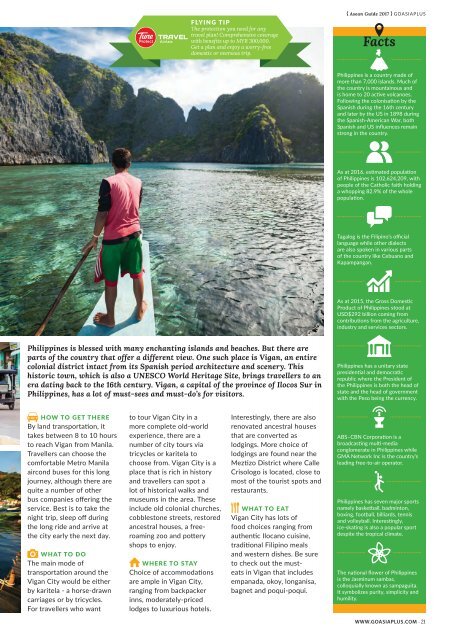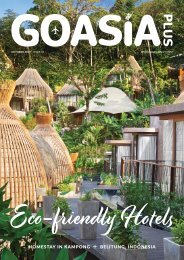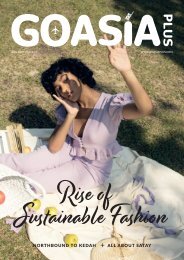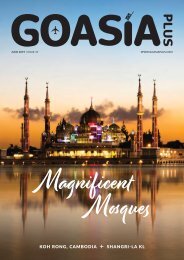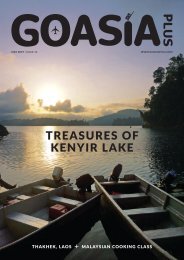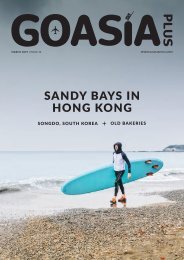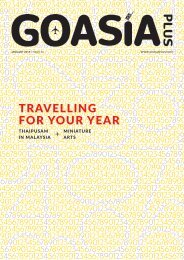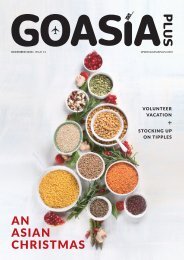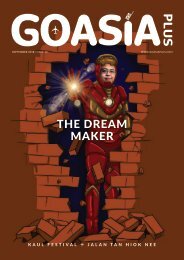The ASEAN Guide 2017
Create successful ePaper yourself
Turn your PDF publications into a flip-book with our unique Google optimized e-Paper software.
FLYING TIP<br />
<strong>The</strong> protection you need for any<br />
travel plan! Comprehensive coverage<br />
with benefits up to MYR 300,000.<br />
Get a plan and enjoy a worry-free<br />
domestic or overseas trip.<br />
{ Asean <strong>Guide</strong> <strong>2017</strong> } GOASIAPLUS<br />
Facts<br />
Philippines is a country made of<br />
more than 7,000 islands. Much of<br />
the country is mountainous and<br />
is home to 20 active volcanoes.<br />
Following the colonisation by the<br />
Spanish during the 16th century<br />
and later by the US in 1898 during<br />
the Spanish-American War, both<br />
Spanish and US influences remain<br />
strong in the country.<br />
As at 2016, estimated population<br />
of Philippines is 102,624,209, with<br />
people of the Catholic faith holding<br />
a whopping 82.9% of the whole<br />
population.<br />
Tagalog is the Filipino’s official<br />
language while other dialects<br />
are also spoken in various parts<br />
of the country like Cebuano and<br />
Kapampangan.<br />
As at 2015, the Gross Domestic<br />
Product of Philippines stood at<br />
USD$292 billion coming from<br />
contributions from the agriculture,<br />
industry and services sectors.<br />
Philippines is blessed with many enchanting islands and beaches. But there are<br />
parts of the country that offer a different view. One such place is Vigan, an entire<br />
colonial district intact from its Spanish period architecture and scenery. This<br />
historic town, which is also a UNESCO World Heritage Site, brings travellers to an<br />
era dating back to the 16th century. Vigan, a capital of the province of Ilocos Sur in<br />
Philippines, has a lot of must-sees and must-do’s for visitors.<br />
Philippines has a unitary state<br />
presidential and democratic<br />
republic where the President of<br />
the Philippines is both the head of<br />
state and the head of government<br />
with the Peso being the currency.<br />
HOW TO GET THERE<br />
By land transportation, it<br />
takes between 8 to 10 hours<br />
to reach Vigan from Manila.<br />
Travellers can choose the<br />
comfortable Metro Manila<br />
aircond buses for this long<br />
journey, although there are<br />
quite a number of other<br />
bus companies offering the<br />
service. Best is to take the<br />
night trip, sleep off during<br />
the long ride and arrive at<br />
the city early the next day.<br />
WHAT TO DO<br />
<strong>The</strong> main mode of<br />
transportation around the<br />
Vigan City would be either<br />
by karitela - a horse-drawn<br />
carriages or by tricycles.<br />
For travellers who want<br />
to tour Vigan City in a<br />
more complete old-world<br />
experience, there are a<br />
number of city tours via<br />
tricycles or karitela to<br />
choose from. Vigan City is a<br />
place that is rich in history<br />
and travellers can spot a<br />
lot of historical walks and<br />
museums in the area. <strong>The</strong>se<br />
include old colonial churches,<br />
cobblestone streets, restored<br />
ancestral houses, a freeroaming<br />
zoo and pottery<br />
shops to enjoy.<br />
WHERE TO STAY<br />
Choice of accommodations<br />
are ample in Vigan City,<br />
ranging from backpacker<br />
inns, moderately-priced<br />
lodges to luxurious hotels.<br />
Interestingly, there are also<br />
renovated ancestral houses<br />
that are converted as<br />
lodgings. More choice of<br />
lodgings are found near the<br />
Meztizo District where Calle<br />
Crisologo is located, close to<br />
most of the tourist spots and<br />
restaurants.<br />
WHAT TO EAT<br />
Vigan City has lots of<br />
food choices ranging from<br />
authentic Ilocano cuisine,<br />
traditional Filipino meals<br />
and western dishes. Be sure<br />
to check out the musteats<br />
in Vigan that includes<br />
empanada, okoy, longanisa,<br />
bagnet and poqui-poqui.<br />
ABS–CBN Corporation is a<br />
broadcasting multi-media<br />
conglomerate in Philippines while<br />
GMA Network Inc is the country’s<br />
leading free-to-air operator.<br />
Philippines has seven major sports<br />
namely basketball, badminton,<br />
boxing, football, billiards, tennis<br />
and volleyball. Interestingly,<br />
ice-skating is also a popular sport<br />
despite the tropical climate.<br />
<strong>The</strong> national flower of Philippines<br />
is the Jasminum sambac,<br />
colloquially known as sampaguita.<br />
It symbolizes purity, simplicity and<br />
humility.<br />
WWW.GOASIAPLUS.COM · 21


